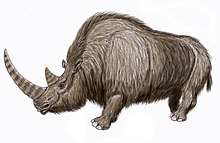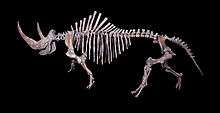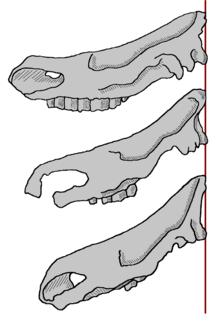Coelodonta
Coelodonta (from the Greek "hollow tooth", in reference to the deep grooves of their molars) is an extinct genus of rhinoceros that lived in Eurasia between 3.7 million years to 10,000 years before the present, in the Pliocene and the Pleistocene epochs.
| Coelodonta | |
|---|---|
 | |
| The woolly rhinoceros, Coelodonta antiquitatis. | |
| Scientific classification | |
| Kingdom: | Animalia |
| Phylum: | Chordata |
| Class: | Mammalia |
| Order: | Perissodactyla |
| Family: | Rhinocerotidae |
| Tribe: | Dicerorhinini |
| Genus: | †Coelodonta Bronn, 1831 |
| Type species | |
| Coelodonta antiquitatis (Blumenbach, 1799) | |
| Species | |
| |
Species


Species recognised as members of Coelodonta, according to Deng et al. (2011), include:
- Coelodonta thibetana (Deng et al. 2011): The most primitive species of the genus, inhabited the Tibetan Plateau during the Pliocene.[1]
- Coelodonta nihowanensis (Chow, 1978): A primitive species from northern China, it lived in the earliest Pleistocene.[1]
- Coelodonta tologoijensis (Beliajeva, 1966): Appeared in northern China around 2 million years ago, spreading to Europe in the Middle Pleistocene, 470,000 years ago. It was probably the direct ancestor of the woolly rhinoceros.[2]
- Coelodonta antiquitatis (Blumenbach, 1799): The type species of the genus, commonly known as the woolly rhinoceros. It lived in the steppes of northern Eurasia during the Late Pleistocene, and was the last living representative of the genus.
Phylogeny
The authors of the description of the species C. thibetana (Deng et al., 2011) proposed a cladogram to place phylogenetically their position in relation to other members of Rhinocerotidae, using the five extant species of rhinoceros and 13 extinct species. They found that Coelodonta was the sister taxon of the species Stephanorhinus hemitoechus.[1] A 2019 study based on a 1.78 million year old Stephanorhinus. sp dental proteome from Georgia confirmed the paraphyly of Stephanorhinus.[3]
| |||||||||||||||||||||||||||||||||||||||||||||||||||||||||||||||||||||||||||||||||||||||||||
References
- Deng, T.; Wang, X.; Fortelius, M.; Li, Q.; Wang, Y.; Tseng, Z.J.; Takeuchi, G.T.; Saylor, J.E.; Säilä, L.K.; Xie, G. (2011). "Out of Tibet: Pliocene Woolly Rhino Suggests High-Plateau Origin of Ice Age Megaherbivores". Science. 333 (6047): 1285–1288. doi:10.1126/science.1206594. PMID 21885780.
- David Garcia Fernández & Juan Vicente i Castells. Nuevas aportaciones al conocimiento de Coelodonta antiquitatis (Blumenbach, 1799) de Brown Bank, Mar del Norte. Butll. Centre d'Est. Natura B-N. VII 13): 309-329 Sta. Coloma de Gramenet, 2008.PDF
- Cappellini, Enrico; Welker, Frido; Pandolfi, Luca; Ramos-Madrigal, Jazmín; Samodova, Diana; Rüther, Patrick L.; Fotakis, Anna K.; Lyon, David; Moreno-Mayar, J. Víctor; Bukhsianidze, Maia; Rakownikow Jersie-Christensen, Rosa (October 2019). "Early Pleistocene enamel proteome from Dmanisi resolves Stephanorhinus phylogeny". Nature. 574 (7776): 103–107. doi:10.1038/s41586-019-1555-y. ISSN 0028-0836. PMC 6894936. PMID 31511700.
External links
| Wikimedia Commons has media related to Coelodonta. |
| Wikispecies has information related to Coelodonta |